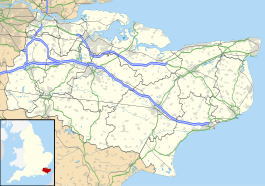Dartford railway station
| Dartford |
|
|---|---|
 |
|
|
Location of Dartford in Kent
|
|
| Location | Dartford |
| Local authority | Borough of Dartford |
| Grid reference | TQ543743 |
| Managed by | Southeastern |
| Station code | DFD |
| DfT category | C1 |
| Number of platforms | 4 |
| Accessible | Yes |
| Fare zone | 8 |
| National Rail annual entry and exit | |
| 2011–12 |
|
| – interchange |
|
| 2012–13 |
|
| – interchange |
|
| 2013–14 |
|
| – interchange |
|
| 2014–15 |
|
| – interchange |
|
| 2015–16 |
|
| – interchange |
|
| Key dates | |
| 30 July 1849 | Station opened |
| Other information | |
| Lists of stations | |
| External links | |
| WGS84 | 51°26′51″N 0°13′09″E / 51.4475°N 0.2193°ECoordinates: 51°26′51″N 0°13′09″E / 51.4475°N 0.2193°E |
|
|
|
Dartford railway station serves the town of Dartford in Kent, England. All train services from the station are operated by Southeastern, which also manages the station. Dartford is a major interchange station in the North Kent region of the Southeastern network. Ticket barriers control access to the platforms.
The station is where three lines from London meet:
Westbound services normally terminate at London Charing Cross, London Cannon Street (both via London Bridge) and London Victoria. Services from London also continue through Dartford to Greenhithe (for Bluewater) to terminate at Gravesend, Strood, Rochester or Gillingham.
Many of the terminating services at Dartford form London bound services, but the remainder will be stabled and maintained at Slade Green Depot approximately two miles West on the North Kent Line There are several sidings to the East of the station where terminating trains can be stabled until such time as needed to return to Dartford to form London bound services or until drivers are available to return the train to Slade Green Depot.
The first station was opened here by the South Eastern Railway it extended its North Kent Line from Gravesend on 30 July 1849, taking the line from there to London. The original station building had an Italianate design; this was replaced by a glass and metal ticket office complex in 1972. A footbridge leads across the line to the two island platforms, which are capable of a very large number of train movements during a working day.
...
Wikipedia

